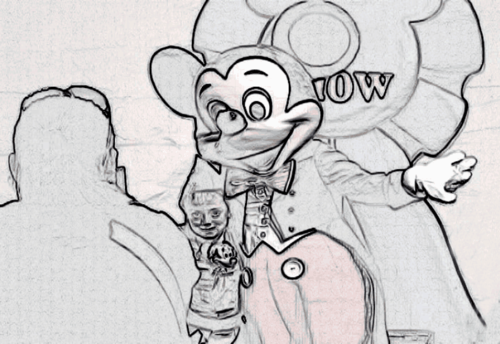
Character performers are not “impersonators” who mimic, say, an Elvis or a Michael Jackson. They are Mickey. Or Minnie. Or Donald. Or they are employees of a very large, very powerful corporation. They wear masks and costumes to resemble fictional characters and put in very ritualized appearances in public. Outside of the structured appearances they are not allowed to be the character they perform the rest of the time; they cannot post pictures of themselves as Mickey on their Facebook; they cannot walk down a street in Anaheim as Mickey Mouse. When they take off their masks, they smoke or put on make up or get on their cell phones. Still, being Mickey Mouse, even for those few, ritually regulated hours, is, apparently, a powerful and sometimes confusing feeling.
This interview was conducted at Mickey Mouse’s home, but because of Disney’s employee regulations, we cannot disclose the location or any other details regarding the performer.
—caraballo-farman
THE BELIEVER: Who are you?
MICKEY MOUSE: I’ve been Mickey Mouse, Minnie Mouse, Piglet, Donald, Abu, Marie, but most of the time I’m just Mickey.
BLVR: What do you do?
MM: I clock in on the wall clock; I go check in with the captain in my area. I check out my costume. You get all the different pieces, your head, your grey shirt, your black shorts, you get as many as you need because you’re probably gonna sweat a lot. You get his head, you get his feet, or his shoes, you get his pants and you have to get the right length too because there’s different lengths depending on your height. You get his vest front, you get his jacket, you get his bow, and you have to get your tennis shoes, that Velcro inside his shoes. You get socks, you get skullcaps—they’re white cloth skullcaps that you tie around the back that covers all your hair while it’s up in a ponytail in the costume. You have to get head gear which is a grey piece that snaps inside the head, and a chinstrap that straps your head in. Gloves, you have to get gloves and that’s a pain because they often have sharpie marks all over them from kids poking the gloves and you can’t get the ink out so it’s hard to find a clean pair of gloves.
You put that all in a big black bag and you carry it to your location or strap it on to a pulley and pull it there and if you forget a piece then you have to go back and get it.
My very first time I pulled on that costume, it was really very...
You have reached your article limit
Sign up for a digital subscription and continue reading all new issues, plus our entire archives, for just $1.50/month.
Already a subscriber? Sign in




